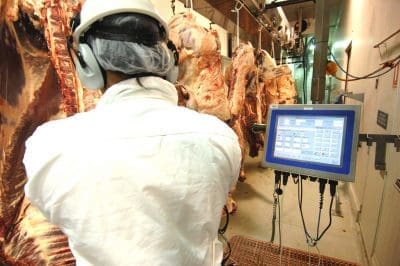DOWNWARDS adjustments continued in some export processor price grids this week, but the changes appeared principally to be about aligning over-the-hooks prices with competitors who changed their quotes earlier.
 This week’s ANZAC Day Thursday holiday, and a May Day holiday for many processors ten days later, will further constrict processor demand for the immediate future. Additionally, Queensland processors are also factoring-in some supply challenges during the week commencing 6 May, as many in the cattle industry attend the Beef 2024 event in Rockhampton.
This week’s ANZAC Day Thursday holiday, and a May Day holiday for many processors ten days later, will further constrict processor demand for the immediate future. Additionally, Queensland processors are also factoring-in some supply challenges during the week commencing 6 May, as many in the cattle industry attend the Beef 2024 event in Rockhampton.
On top of that, there been some localised rain disruptions in Queensland this past week which has seen some slaughter cattle deliveries again postponed.
2024 season looks like being ‘condensed’
‘Disruption’ and ‘postponement’ are words we’ve used frequently in this weekly kill report in the opening four months of 2024, due to weather challenges.
The effect has been to condense the current slaughter season somewhat – potentially causing some congestion in supply over the next four to six months. One large Northwest Queensland beef producer spoken to during the past week estimated his business is currently 33 days behind its normal seasonal cycle, in terms of musters and cattle turnoff.
That’s not uncommon across the extensive northern pastoral regions, and it heightens the risk of too many cattle being presented at the same time in coming months.
Some grids back another 10c
Some large Queensland multi-site processors have taken 10c/kg off their grids as of yesterday. Others (which are unchanged this week) took similar steps last week, to better align supply and demand.
Offers among competitive southern Queensland export processors this morning include heavy cows quoted at 450c/kg and four-tooth grass ox with implant at 515-520c/kg. Some operators are offering priced quotes only for the next couple of weeks, with space bookings only for May spaces beyond that.
Central Queensland plants are 10c/kg less in current grids due to the freight differential, and 25c less in North Queensland.
Weekend rain across the Burnett region and elsewhere saw a few more postponements occur in Queensland processing activity this week, but realistically, cattle delayed earlier were stacked up behind them and all operators we spoke to for this report expect to complete a full roster this week (ANZAC Day excepted).
Further south, following some 20c/kg price falls last week, processors in eastern regions of South Australia have grids at 520c/kg on best cows, and 550c on four tooth export bullocks. Southern NSW processor grids are mostly unchanged this week with heavy cows around 460c/kg and four-tooth HGP-free ox 560c.
Kill surge continues
The NLRS weekly slaughter report was issued unusually early this week, suggesting seven-day national kills to Friday reached 134,500 head – the second largest tally so far this year. Part of that may have been due to stockpiling a little more beef in anticipation of this week’s shortened trading cycle, but the trend over the past eight weeks (Easter excepted) has been sharply higher.
JBS has another small incremental expansion in throughput planned ahead for the company’s Dinmore plant, but this alone won’t make a substantive change to industry capacity, as larger numbers of Queensland cattle start moving.
Export meat trade has taken a breather this week, with the recent manufacturing beef price surge plateauing for the time being. One big export trader who was selling lean frozen trimmings above US300c/lb this time last week is now back in the 290s.
New Zealand is yet to hit its straps in annual dairy cow slaughter for manufacturing meat, but NZ kills are noticeably on the rise in recent weeks – in response to US price signals.
Saleyard numbers dive
Most physical sales held early this week have contracted in offering size – partly in reaction to last week’s sharp price drops, but also because vendors saw the risk of reduced processor demand this week due to Thursday’s public holiday.
Gunnedah sale this morning almost halved in size to 1340. There were insufficient well finished grown cattle to quote. Processor demand for cows continued to slide, with well-finished heavyweights down as much as 16-18c/kg, while a good restocker order helped the plainer conditioned cows.
Wodonga sale also halved in size this week, to 970 head, with only a limited supply of well-finished cattle. Not all buyers were active, particularly in the export class. The market saw mixed trends, and prices were distorted due to the lack of numbers. Few heavy steers were offered, with the bulk selling from 247-310c. The cow market gained pace for the better-finished heavy types, although prices slipped 16c averaging 231c/kg. Leaner cows sold from 136-175c/kg.
A preliminary report from this morning’s Roma store sale had a yarding of 7414, down about 1800 on last week. Scattered showers in the local areas had some impact. With the pressure of the large numbers prices continued to soften. Grown steers 500-600kg sold from 226-338c/kg. Full report tomorrow.
Forbes sale yesterday yarded 1111, down 441 on last week, with a larger percentage of plainer western cattle penned along with the better types. Heavy steers and bullocks dropped 15c receiving from 230 to 295c/kg; grown heifers ranged from 225 to 280c/kg; and cows fell 20-30c with heavy 2 score from 160 to 210 and 3 score 207 to 215c/kg.
Pakenham’s numbers more than halved yesterday to 822 head. Grown steers lost 20c while bullocks eased 5c/kg, trading from 280-331c/kg. Cows gave back 20c to 30c/kg. Most light and medium weight cows sold between 80c and 228c/kg. Heavyweight cows made mostly from 150c to 240c/kg.
